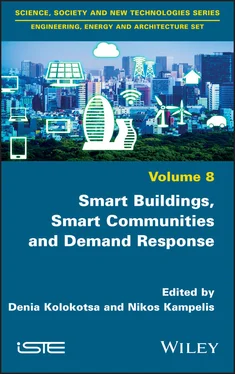Firstly, a comprehensive approach for evaluating the performance of industrial and residential smart energy buildings/NZEBs is presented. A detailed audit of construction characteristics, installed systems and controls is conducted and presented. Subsequently, holistic data from advanced metering and sensor equipment are explored to verify energy consumption and actual building energy performance. Dynamic energy models are developed, validated and tested to explore key aspects of the operational behavior of buildings and systems, and draw essential knowledge about their performance. Consumption data based on real measurements is compared, on one hand, with dynamic building model simulation results and on the other hand, with the initial annual energy consumption, obtained via the building’s energy efficiency certification scheme prior to construction. Findings are explored to address the actual performance gap, reflect on the limitations of each approach and highlight important conclusions.
Secondly, the book focuses on how DR can be applied at the building level. A novel evaluation and optimization methodology, in the context of the building level DR, is presented. To this end, DR is assessed with the aid of an RTP scheme based on the actual energy market data. In this context, HVAC system performance is evaluated according to the energy consumption, the corresponding energy costs and the indoor thermal comfort.
Thirdly, the book describes how DR can be applied at the community level by exploiting predictions of day-ahead consumption and/or production and load shifting. The benefits of this approach are evaluated in terms of the economic savings based on a flat versus ToU tariff and an RTP scheme. The reliable prediction of power consumption and/or production 24 hours ahead is performed using artificial neural network modeling, whereas load shifting optimization is conducted using a genetic algorithm dual-objective optimization algorithm.
In Chapter 2, the smart and zero energy building facilities used as case studies for evaluating DR at the building and the community levels are presented.
Chapter 3provides a thorough analysis of the performance of residential and industrial buildings with the aid of measurements and how they can be utilized for building energy modeling and validation purposes.
Chapter 4presents a newly developed approach for optimizing the operation of HVAC systems from a DR perspective.
Chapter 5presents a novel approach for the community level prediction and optimization in a DR setting.
Finally, the overall conclusions and recommendations arising from the findings of this research are presented.
The editors express their deepest appreciation to all the authors for their contribution and to the European Commission, for allocating the funds in order for the Smart GEMS project to be implemented. Special thanks are owed to Dr. Cristina Cristalli, Head of Research for Innovation in the Loccioni Group and to the Loccioni Group for providing access and support for research activities in the framework of Smart GEMS project to be conducted in their industrial high-end facilities.
Nikos KAMPELIS
September 2020
| AC |
Alternating Current |
| AMI |
Advanced Metering Infrastructure |
| ANN |
Artificial Neural Network |
| ARC |
Aggregators or Retail Customers |
| AS |
Ancillary Services |
| BEMS |
Building Energy Management System |
| biPV |
Building-Integrated PhotoVoltaic |
| CHP |
Cogeneration of Heat and Power |
| CO 2-eq |
Carbon Dioxide Equivalent Emissions |
| COP |
Coefficient Of Performance |
| CPP |
Critical Peak Pricing |
| CSP |
Curtailment Service Provider |
| Cv |
Coefficient of Variance |
| DA |
Day Ahead |
| DARTP |
Day-Ahead Real-Time Pricing |
| DC |
Direct Current |
| DEMS |
District Energy Management Systems |
| DER |
Distributed Energy Resources |
| DG |
Diesel Generator |
| DHW |
Domestic Hot Water |
| DR |
Demand Response |
| DRP |
Demand Response Providers |
| DSM |
Demand Side Management |
| DSO |
Distribution System Operator |
| EED |
Energy Efficiency Directive |
| EER |
Energy Efficiency Ratio |
| EMS |
Energy Management System |
| ESCO |
Energy Service COmpany |
| FC |
Fuel Cell |
| GA |
Genetic Algorithm |
| HRES |
Hybrid Renewable Energy System |
| HVAC |
Heating, Ventilation and Air Conditioning |
| ID |
Integrated Design |
| IoT |
Internet of Things |
| IPMVP |
International Performance Measurement and Verification Protocol |
| MAPE |
Mean Absolute Percentage Error |
| MBE |
Mean Bias Error |
| MILP |
Mixed Integer Linear Programming |
| MINLP |
Mixed Integer NonLinear Programming |
| MIP |
Mixed Integer Programming |
| MPPT |
Maximum Power Point Tracking |
| MT |
Micro-Turbine |
| NARX |
Nonlinear AutoRegressive ANN with eXogenous input |
| NIST |
National Institute of Standards and Technology |
| NZEB |
Near-Zero Energy Building |
| OpenADR |
Open Automated Demand Response |
| PMV |
Predicted Mean Vote |
| PPD |
Percentage of People Dissatisfied |
| PSO |
Particle Swarm Optimization |
| PV |
PhotoVoltaic |
| RES |
Renewable Energy Sources |
| RH |
Relative Humidity |
| RMSE |
Root Mean Squared Error |
| RTO |
Regional Transmission Operator |
| RTP |
Real-Time Pricing |
| SaaS |
Software as a Service |
| SDG |
Sustainable Development Goal |
| ToU |
Time of Use |
| VEN |
Virtual End Node |
| VTN |
Virtual Transfer Node |
| WT |
Wind Turbine |
| ZEB |
Zero Energy Building |
| C i |
Day-ahead price per hour for hours 1–24 |
| C _( E , T ) |
Total energy plus taxes (€) |
 |
Day-ahead hourly unit cost of energy in each building (€/kWh) |
| C T |
Total tax charges (€) |
| C S |
Energy procurement cost (€) |
| C N |
Network services cost (€) |
| C S,F |
Energy procurement fixed cost component (€/kWh) |
| C EDD |
Daily excise duty on electricity and taxes (€) |
| C v,u |
Various costs normalized per kWh (€/Wh) |
| C F |
Fixed cost component (€) |
| C pmax |
Maximum power cost component (€/kW) |
| C AT |
Active energy cost component (€/kWh) |
| C A–UC |
Fixed cost for up to 4 GWh per month (€/kWh |
| C EDH |
Excise duty per kWh (€/kWh) |
| C FAA |
Parameter to account for F, AT, and A-UC components (€/kWh) |
| C pmax,F |
Maximum power fixed cost component (€/kW) |
| Icl |
Clothing insulation (m 2K/W) |
| IVA |
Value added tax (€) |
| Load Shift |
Daily load shift (kWh) |
 |
GA optimized hourly electrical energy (kWh) at building or building group level |
| M |
Metabolic rate (W/m 2) |
| P i |
Hourly average power consumption of the HVAC in kW (equivalent to kWh) |
 |
Hourly temperature set points of the HVAC system the next day |
| C ost E |
Daily energy operating costs (€) |
| C ost E_Lap |
Daily energy operating costs of Leaf Lab (L4) building (€) |
| C ost E_Summa |
Daily energy operating costs of Summa (L2) building (€) |
| C ost E__kite |
Daily energy operating costs of Kite (L5) building (€) |
| DA h |
Day-ahead market prices (€/kWh) |
| DA N,h |
DA price flexible factor per hour ℎ (€/kWh) |
| R |
Pearson’s coefficient |
| RH |
Relative humidity (%) |
| T air |
Air temperature (T air) (°C) |
| Tr |
Mean radiant temperature (°C) |
| Vair |
Relative air velocity (m/s) |
| W |
Effective mechanical power (W/m 2) |
| W c |
Weighting coefficient for the daily operational cost of energy for the HVAC |
| w pmv |
Weighting coefficient for the daily thermal comfort |
 |
Hourly value of total energy consumption in each building (kWh) |
 |
Baseline hourly electrical energy (kWh) based on day-ahead neural network predictions |
Chapter written by Nikos KAMPELIS.
Читать дальше

















